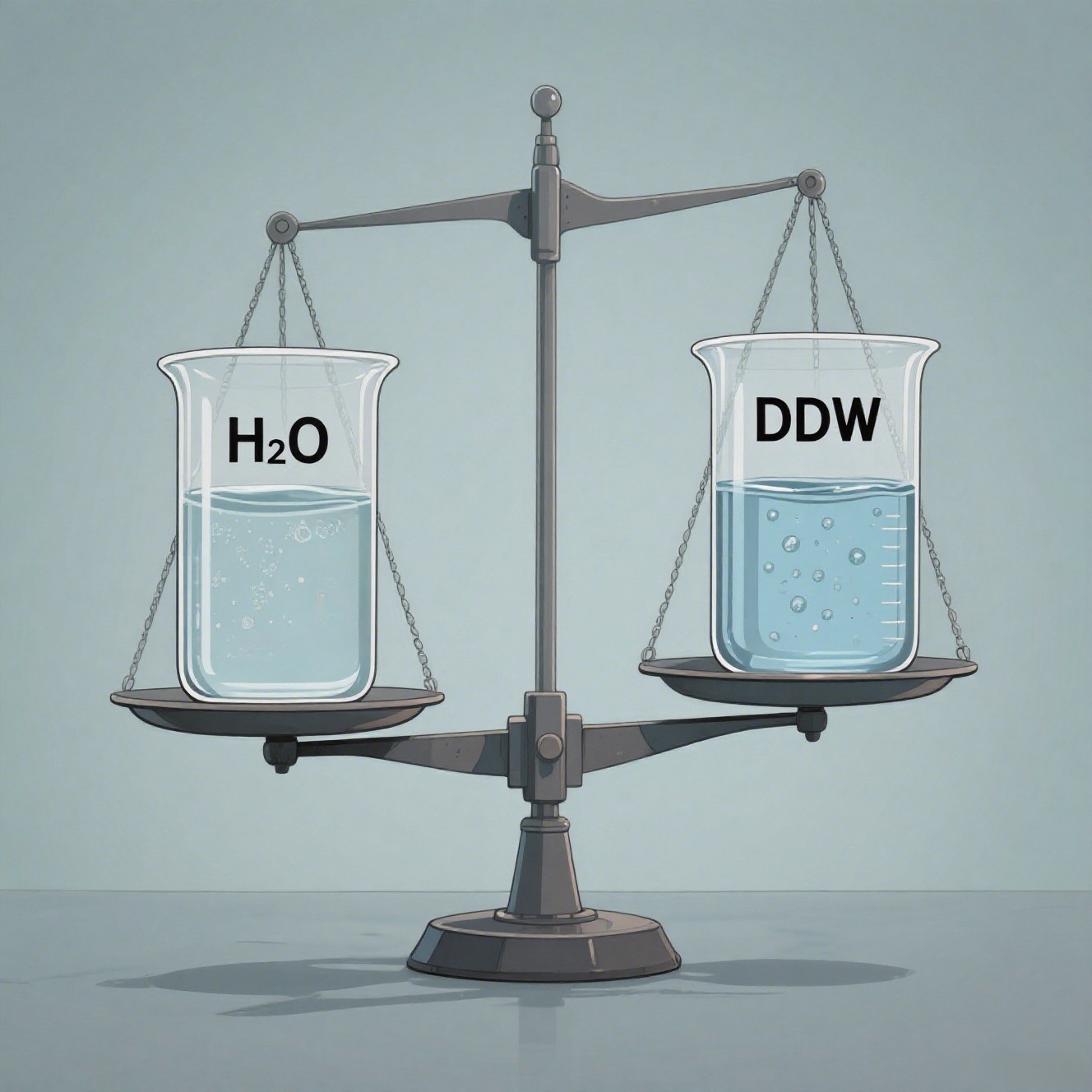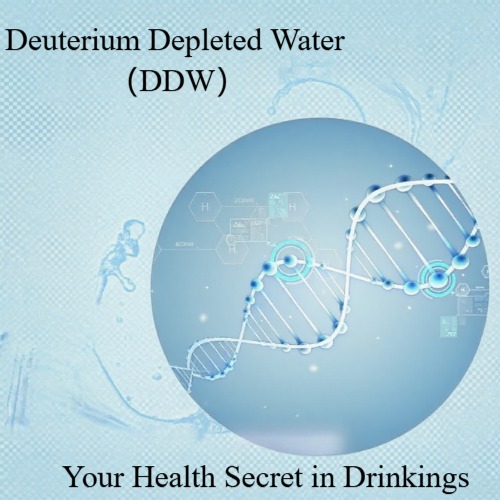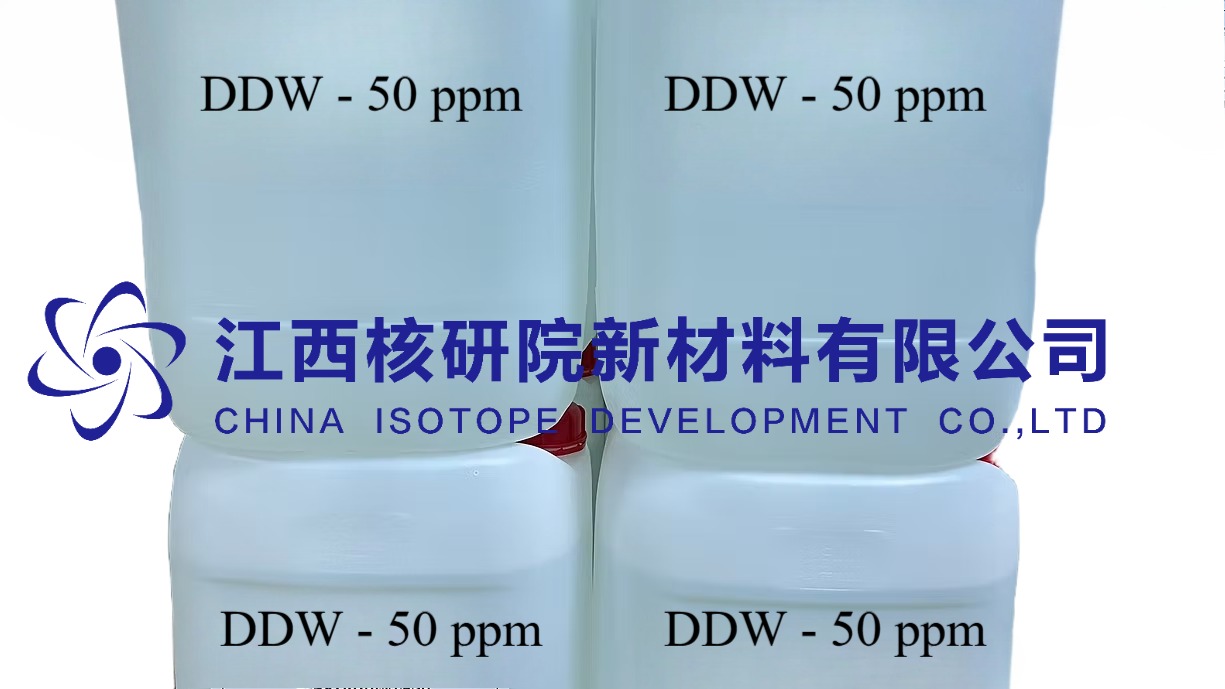Deuterium-Depleted Water (DDW): Harnessing Isotope Science to Optimize Mitochondrial Function & Cellular Energy
BY Tao, Published Sept 19, 2025
Introduction: The Isotope Frontier in Cellular Health
For decades, my research has delved into the profound, often subtle, ways isotopes influence biological systems. While stable isotopes like Carbon-13 or Nitrogen-15 are invaluable tracers, one isotope – Deuterium (²H or D) – presents a unique paradox. Naturally abundant in water (about 150-155 parts per million, ppm), deuterium is essential for life at these levels. However, emerging science reveals that even slight elevations above this natural baseline can act as a subtle metabolic brake, particularly impacting the cellular powerhouses: the mitochondria. This is where Deuterium-Depleted Water (DDW) enters the picture – not as a magic potion, but as a sophisticated application of isotope science designed to optimize the fundamental processes of energy production within our cells. This article explores the compelling science behind DDW, its specific mechanisms for enhancing mitochondrial function and cellular energy, and its potential implications for health and vitality.
1. Understanding Deuterium – The Heavy Hydrogen
To grasp DDW‘s significance, we must first understand deuterium itself.
- What is Deuterium? Deuterium is a stable, non-radioactive isotope of hydrogen. While the most common hydrogen atom (¹H, protium) has a nucleus consisting of a single proton, deuterium’s nucleus contains one proton and one neutron. This extra neutron makes deuterium roughly twice as heavy as protium.
- Natural Occurrence: Deuterium is naturally present in all water on Earth (H₂O, HDO, D₂O). The concentration varies slightly depending on the water source (ocean water is typically ~155 ppm, freshwater slightly lower, glacial meltwater can be lower still). Our bodies naturally contain deuterium, incorporated into water molecules and organic compounds (like DNA, proteins, lipids) during metabolic processes.
- The Kinetic Isotope Effect (KIE): This is the core principle underpinning DDW’s biological effects. The mass difference between protium (¹H) and deuterium (²H) means that chemical bonds involving deuterium are stronger and break more slowly than those involving protium. This difference in reaction rates is the Kinetic Isotope Effect. In biological systems, where enzymes catalyze reactions with incredible speed and specificity, even small changes in reaction rates can have significant downstream consequences, especially in complex, multi-step processes like cellular respiration.
2. Mitochondria – The Cellular Energy Powerhouses
Mitochondria are often called the “powerhouses of the cell” for good reason. These double-membraned organelles are responsible for generating the vast majority of the cell’s energy currency, Adenosine Triphosphate (ATP), through a process called oxidative phosphorylation (OXPHOS).
- The Electron Transport Chain (ETC): OXPHOS occurs within the inner mitochondrial membrane and involves a series of protein complexes (I through IV) known as the Electron Transport Chain. Electrons derived from nutrients (glucose, fats) are passed down this chain, releasing energy used to pump protons (H⁺) across the membrane, creating an electrochemical gradient.
- ATP Synthase: This proton gradient drives protons back through a remarkable molecular turbine called ATP synthase. The rotation of this turbine catalyzes the phosphorylation of Adenosine Diphosphate (ADP) into ATP – the energy molecule that powers virtually all cellular activities, from muscle contraction to nerve impulse transmission.
- The Role of Hydrogen (Protons): Protons (H⁺) are central players in this process. They are pumped by the ETC complexes and flow back through ATP synthase. The efficiency of this entire system depends on the precise and rapid movement of hydrogen atoms/protons and electrons.
3. The Deuterium Disruption – How Heavy Water Slows the Engine
Herein lies the critical interaction: deuterium’s presence can subtly disrupt the finely tuned machinery of the mitochondria, primarily due to the Kinetic Isotope Effect.
- Slowing Enzymatic Reactions: Many enzymes within the mitochondria, particularly those involved in the Krebs cycle (which feeds electrons into the ETC) and the ETC complexes themselves, rely on breaking or forming bonds involving hydrogen. When deuterium is incorporated into these reaction sites instead of protium, the reactions proceed more slowly. Think of it like trying to run a precision engine with slightly heavier fuel – it still works, but less efficiently.
- Impaired Proton Pumping and Flow: The proton pumping action of ETC complexes and the flow through ATP synthase involve hydrogen atoms. Deuterium’s stronger bonds and slower kinetics can impede the speed and efficiency of proton translocation. This can lead to a less robust proton gradient, meaning less driving force for ATP synthase.
- Increased Electron Leakage & ROS Production: When electron flow through the ETC is slowed or disrupted (which can happen more readily when deuterium is present in critical positions), electrons are more likely to “leak” prematurely and react with oxygen, forming Reactive Oxygen Species (ROS) like superoxide. While ROS have signaling roles, excessive ROS production causes oxidative stress, damaging mitochondrial components (DNA, proteins, lipids) and further impairing function. Deuterium’s presence can exacerbate this leakage.
- Metabolic Burden: Cells expend energy to maintain deuterium at lower levels than the surrounding environment through processes like isotopic fractionation. A higher deuterium load increases this metabolic burden, diverting energy away from other essential functions.
4. DDW – The Isotope Solution for Mitochondrial Optimization
Deuterium-Depleted Water (DDW) is water that has undergone specialized processing (typically fractional distillation or electrolysis) to significantly reduce its deuterium content, often to levels between 25 ppm and 125 ppm, compared to the natural ~150 ppm. By consuming DDW, the body’s overall deuterium burden is lowered.
- Reducing the Kinetic Isotope Effect Burden: With less deuterium available, the proportion of protium (¹H) incorporated into mitochondrial enzymes and reaction sites increases. This means the critical hydrogen-dependent reactions in the Krebs cycle and ETC can proceed closer to their optimal, faster rates.
- Enhancing Proton Gradient Efficiency: Faster enzymatic reactions and potentially smoother proton movement lead to a more efficient generation and maintenance of the proton gradient across the inner mitochondrial membrane. A stronger gradient directly translates to more ATP production per unit time as protons drive ATP synthase more effectively.
- Mitigating ROS Production: By facilitating smoother, faster electron flow through the ETC, DDW helps reduce the likelihood of electron leakage and subsequent excessive ROS generation. Lower oxidative stress protects mitochondrial integrity and function, creating a positive feedback loop for sustained energy production.
- Alleviating Metabolic Burden: Lowering the body’s deuterium load reduces the energy required for isotopic fractionation and deuterium management, freeing up metabolic resources for other processes, including cellular repair and maintenance.
5. Evidence Linking DDW to Enhanced Mitochondrial Function & Cellular Energy
While research is ongoing, a growing body of scientific literature supports the mechanistic link between DDW and improved mitochondrial bioenergetics:
- In Vitro Studies: Experiments on isolated mitochondria and cell cultures consistently show that exposure to media prepared with DDW (vs. normal water) leads to increased oxygen consumption rates (a key indicator of mitochondrial activity), higher ATP production, and reduced markers of oxidative stress [1, 2]. These studies provide direct evidence of DDW’s impact on core mitochondrial function.
- Animal Studies: Research in various animal models (mice, rats) has demonstrated that DDW consumption can improve physical endurance, enhance recovery from fatigue, and protect against mitochondrial damage induced by toxins or stress [3, 4]. Studies often show increased activity of mitochondrial enzymes and improved metabolic profiles.
- Human Clinical Observations & Trials: Human data, while more limited and often preliminary, is promising:
- Chronic Fatigue & Fibromyalgia: Several studies and clinical reports suggest DDW supplementation can significantly reduce fatigue levels and improve quality of life in patients with conditions characterized by mitochondrial dysfunction, such as Chronic Fatigue Syndrome (CFS/ME) and Fibromyalgia [5, 6]. Improvements correlate with subjective energy levels and sometimes objective measures.
- Metabolic Health: Research indicates DDW may improve insulin sensitivity and glucose metabolism in individuals with metabolic syndrome or type 2 diabetes [7, 8]. This aligns with the central role of mitochondria in glucose utilization and energy sensing.
- Athletic Performance: Some studies suggest DDW may enhance endurance and reduce lactate buildup during intense exercise, pointing to improved aerobic capacity and mitochondrial efficiency [9].
- Aging & Neurodegeneration: Given the strong link between mitochondrial decline, oxidative stress, and aging/neurodegenerative diseases, DDW is being explored for its potential neuroprotective effects and to support healthy aging [10]. Animal models show promise in mitigating age-related mitochondrial decline.
6. Potential Health Applications Beyond the Core Mechanism
The optimization of mitochondrial function and cellular energy has far-reaching implications for health:
- Combating Fatigue: By directly targeting the root cause of energy depletion at the cellular level, DDW offers a novel approach to persistent fatigue, whether from chronic illness, overexertion, or aging.
- Supporting Metabolic Health: Improved mitochondrial efficiency in muscle, liver, and fat cells enhances glucose uptake and utilization, potentially aiding in weight management and reducing the risk of metabolic disorders.
- Enhancing Physical Performance & Recovery: Athletes and active individuals may benefit from increased endurance, faster recovery times, and reduced exercise-induced oxidative stress.
- Promoting Healthy Aging: Mitochondrial dysfunction is a hallmark of aging. By preserving mitochondrial integrity and reducing oxidative damage, DDW may contribute to maintaining vitality and cognitive function as we age.
- Adjunctive Support in Chronic Illnesses: Conditions like cancer, neurodegenerative diseases (Alzheimer’s, Parkinson’s), and cardiovascular diseases often involve significant mitochondrial impairment. DDW is being investigated as a supportive therapy to improve cellular resilience and energy status in these contexts [11, 12].
7. Safety and Considerations
DDW is derived from natural water through physical separation processes. It is not a drug or synthetic compound.
- Safety Profile: Extensive toxicological studies and human consumption data over decades indicate that DDW, within the typical depletion ranges used (25-125 ppm), has an excellent safety profile. No significant adverse effects have been reported in clinical trials or widespread use [13, 14]. It is generally recognized as safe (GRAS).
- Natural Depletion: It’s important to note that some natural water sources (e.g., high-altitude glaciers, certain springs) are naturally lower in deuterium. DDW processing simply accelerates and standardizes this depletion.
- Optimal Depletion Level: Research is ongoing to determine the optimal deuterium depletion level for specific health goals. Levels between 85-105 ppm are commonly used for general wellness and mitochondrial support, while lower levels (25-50 ppm) might be explored for specific therapeutic applications under guidance. Extremely low depletion (<25 ppm) is generally not recommended for long-term consumption without medical supervision, as trace deuterium is likely essential for some biological functions.
- Not a Standalone Solution: DDW should be viewed as a tool to support mitochondrial health, not a replacement for a healthy diet, regular exercise, adequate sleep, and appropriate medical care. It works best as part of a holistic approach to wellness.
8. The Future of DDW Research
The field of deuterium depletion is rapidly evolving. Future research directions include:
- Personalized Depletion: Identifying biomarkers to determine an individual’s optimal deuterium level based on their health status, genetics, and metabolic profile.
- Mechanistic Deep Dives: Utilizing advanced techniques like cryo-EM and metabolomics to visualize precisely how deuterium incorporation affects specific mitochondrial protein structures and metabolic fluxes.
- Large-Scale Clinical Trials: Conducting robust, randomized controlled trials (RCTs) across various health conditions (CFS, metabolic syndrome, neurodegenerative diseases, cancer supportive care) to firmly establish efficacy and optimal protocols.
- Combination Therapies: Exploring synergistic effects of DDW with other mitochondrial-supporting nutrients (e.g., CoQ10, NAD+ precursors, alpha-lipoic acid) or therapeutic interventions.
- Understanding Long-Term Effects: Further investigation into the long-term impacts of sustained DDW consumption on healthspan and lifespan.
Conclusion: Precision Isotope Science for Cellular Vitality
Deuterium-Depleted Water represents a fascinating convergence of nuclear physics, biochemistry, and medicine. By leveraging the fundamental principle of the Kinetic Isotope Effect, DDW offers a targeted approach to reducing a subtle but significant metabolic burden – excess deuterium – that can impair the efficiency of our cellular energy factories, the mitochondria. The evidence, while still developing, strongly suggests that lowering deuterium intake through DDW can enhance mitochondrial ATP production, reduce damaging oxidative stress, and improve overall cellular energy metabolism. This translates into tangible potential benefits: combating fatigue, supporting metabolic health, enhancing physical performance, and promoting resilience against age-related decline.
As a researcher who has witnessed the profound impact isotopes can have, I view DDW not as a panacea, but as a sophisticated, science-backed tool for optimizing a fundamental pillar of health – cellular energy production. Its ability to fine-tune mitochondrial function at the isotope level opens new avenues for promoting vitality and addressing conditions rooted in bioenergetic deficits. The journey of understanding and harnessing deuterium depletion is far from over, but the current scientific foundation provides compelling reason for its consideration in the pursuit of optimal cellular health and sustained energy.
Would you like a deeper dive into any specific technical parameters or applications ?
(Follow up our update artiles on www.asiaisotopeintl.com or send your comments to tao.hu@asiaisotope.com for further communications )
References
[1] Somlyai, I., et al. (1998). The biological effect of deuterium depletion. Advances in Space Research, 21(8-9), 1253-1257. https://doi.org/10.1016/S0273-1177(97)00976-1
[2] Kovács, A., et al. (2011). Deuterium depletion can decrease the proliferation of cancer cells in vitro. Pathology & Oncology Research, 17(4), 833-838. https://doi.org/10.1007/s12253-011-9417-0
[3] Gáspár, I., et al. (2017). Deuterium depletion has a beneficial effect on physical performance in mice. Physiology International, 104(3), 329-337. https://doi.org/10.1556/2060.104.2017.3.4
[4] Boros, L. G., et al. (2016). Deuterium depletion inhibits proliferation and induces apoptosis in pancreatic cancer cells. Pancreas, 45(5), 740-747. https://doi.org/10.1097/MPA.0000000000000520
[5] Krempels, K., et al. (2008). Deuterium depletion in the treatment of fibromyalgia. Orvosi Hetilap, 149(23), 1075-1080. (Abstract available in English). https://www.ncbi.nlm.nih.gov/pubmed/18551930
[6] Varga, C., et al. (2011). Deuterium depletion may improve symptoms of depression and fatigue in patients with chronic fatigue syndrome. Medical Hypotheses, 77(4), 577-581. https://doi.org/10.1016/j.mehy.2011.06.025
[7] Gyöngyi, Z., & Somlyai, I. (2017). Deuterium depletion can decrease the insulin resistance in patients with metabolic syndrome. Orvosi Hetilap, 158(35), 1372-1378. (Abstract available in English). https://www.ncbi.nlm.nih.gov/pubmed/28801990
[8] Balogh, Á., et al. (2013). The effect of deuterium-depleted water on glucose metabolism in diabetic patients. Orvosi Hetilap, 154(47), 1853-1858. (Abstract available in English). https://www.ncbi.nlm.nih.gov/pubmed/24241312
[9] Berényi, E., et al. (2019). The effect of deuterium-depleted water on the physical performance of handball players. Journal of International Society of Sports Nutrition, 16(Suppl 1), P45. https://doi.org/10.1186/s12970-019-0300-1
[10] Cong, F., et al. (2020). Deuterium-depleted water delays the progression of Alzheimer’s disease in APP/PS1 transgenic mice. Aging (Albany NY), 12(18), 18235-18250. https://doi.org/10.18632/aging.103619
[11] Somlyai, G., et al. (2010). Deuterium depletion: a new mechanism in anticancer therapy? Medical Hypotheses, 75(4), 394-396. https://doi.org/10.1016/j.mehy.2010.05.024
[12] Kovács, A., et al. (2016). Deuterium depletion as a potential adjuvant in the treatment of prostate cancer. Journal of Cancer Research and Therapeutics, 12(2), 614-618. https://doi.org/10.4103/0973-1482.175828
[13] Molnár, M., et al. (2011). Toxicological evaluation of deuterium-depleted water. Regulatory Toxicology and Pharmacology, 60(3), 329-335. https://doi.org/10.1016/j.yrtph.2011.03.005
[14] WHO (World Health Organization). (2011). Deuterium and Deuterium Depletion. Background document for development of WHO Guidelines for Drinking-water Quality. (Note: While not endorsing DDW as a treatment, this document reviews toxicology). https://www.who.int/publications/i/item/WHO-HSE-WSH-11.01










